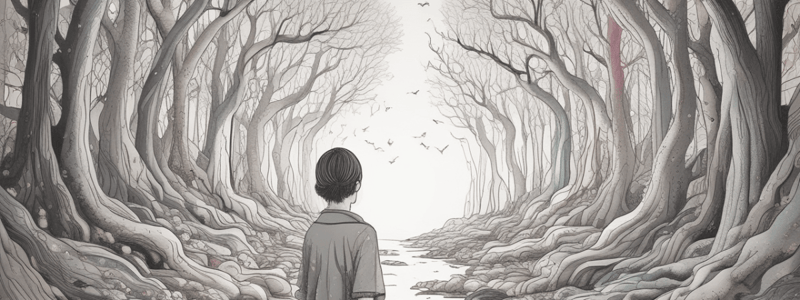Podcast
Questions and Answers
Under DSM-5, separation anxiety disorder is categorized under trauma- and stressor-related disorders.
Under DSM-5, separation anxiety disorder is categorized under trauma- and stressor-related disorders.
False (B)
The ICD-10 category F93 includes emotional disorders with specific onset in childhood.
The ICD-10 category F93 includes emotional disorders with specific onset in childhood.
True (A)
Generalized anxiety disorder has an equivalent designation in ICD-10.
Generalized anxiety disorder has an equivalent designation in ICD-10.
False (B)
Family aggregation and genetic studies suggest a lower risk of anxiety for individuals with family members who have experienced anxiety.
Family aggregation and genetic studies suggest a lower risk of anxiety for individuals with family members who have experienced anxiety.
Sibling relational disorder in DSM-5 is termed as sibling rivalry disorder in ICD-10.
Sibling relational disorder in DSM-5 is termed as sibling rivalry disorder in ICD-10.
Obsessive-compulsive disorder is categorized under obsessive-compulsive and related disorders in DSM-5.
Obsessive-compulsive disorder is categorized under obsessive-compulsive and related disorders in DSM-5.
Childhood anxiety disorders increase the risk of later disorders in adulthood.
Childhood anxiety disorders increase the risk of later disorders in adulthood.
Early detection and treatment of childhood anxiety disorders can exacerbate a child's developmental impairment.
Early detection and treatment of childhood anxiety disorders can exacerbate a child's developmental impairment.
Social anxiety disorder in DSM-5 is equivalent to social phobia in ICD-10.
Social anxiety disorder in DSM-5 is equivalent to social phobia in ICD-10.
Trauma- and stressor-related disorders are listed under category F93 in ICD-10.
Trauma- and stressor-related disorders are listed under category F93 in ICD-10.
Exposure to adverse life events and negative information are considered environmental factors contributing to childhood anxiety disorders.
Exposure to adverse life events and negative information are considered environmental factors contributing to childhood anxiety disorders.
Specific phobia is also called phobic anxiety disorder of childhood in ICD-10.
Specific phobia is also called phobic anxiety disorder of childhood in ICD-10.
Combination treatment with SSRIs and cognitive behavioural therapy is always less effective than cognitive behavioural therapy alone.
Combination treatment with SSRIs and cognitive behavioural therapy is always less effective than cognitive behavioural therapy alone.
Childhood anxiety disorders can be a predictor of later major depression.
Childhood anxiety disorders can be a predictor of later major depression.
Anxiety disorders are more common in boys than in girls.
Anxiety disorders are more common in boys than in girls.
ICD-10 categorizes obsessive-compulsive disorder and post-traumatic stress disorder under anxiety disorders.
ICD-10 categorizes obsessive-compulsive disorder and post-traumatic stress disorder under anxiety disorders.
DSM-5 includes sibling rivalry disorder under 'Relational Disorders'.
DSM-5 includes sibling rivalry disorder under 'Relational Disorders'.
Surveys indicate that the overall prevalence rates of anxiety disorders in children can range from 1% to 24%.
Surveys indicate that the overall prevalence rates of anxiety disorders in children can range from 1% to 24%.
In later adolescence, rates of generalized anxiety disorder and panic disorder start to decrease.
In later adolescence, rates of generalized anxiety disorder and panic disorder start to decrease.
During preschool years, children commonly have separation anxiety and fears of animals, imaginary creatures, and the dark.
During preschool years, children commonly have separation anxiety and fears of animals, imaginary creatures, and the dark.
Anxiety disorders do not significantly impair children's functioning.
Anxiety disorders do not significantly impair children's functioning.
Anxiety about social situations and personal adequacy becomes prominent in early adolescence.
Anxiety about social situations and personal adequacy becomes prominent in early adolescence.
Flashcards are hidden until you start studying
Study Notes
Anxiety Disorders in Childhood
- Anxiety disorders are the most common mental disorders in childhood, affecting girls more than boys.
- Fear and anxiety play important roles in functioning and have major evolutionary significance.
Classification
- ICD-10 classifies anxiety disorders in childhood as "Emotional disorders with onset specific to childhood."
- DSM-5 categorizes all childhood and adult anxiety disorders together, separating obsessive-compulsive disorder and post-traumatic stress disorder into their own sections.
- ICD-10 recognizes sibling rivalry disorder, while DSM-5 classifies it under "Relational Disorders."
Prevalence
- Anxiety disorders are the most prevalent mental disorders in childhood, affecting 5-10% of children.
- Phobias and separation anxiety are most common in childhood, while social anxiety becomes more prominent in adolescence.
- Individual studies have documented rates ranging from 1% to 24%.
Anxiety at Different Ages
- Infants experience a period of fear of strangers.
- During preschool years, separation anxiety and fears of animals, imaginary creatures, and the dark are common.
- Early adolescence sees these fears replaced by anxiety about social situations and personal adequacy.
- Later adolescence sees a rise in rates of generalized anxiety disorder and panic disorder.
Aetiology
- Family aggregation and genetic studies indicate a higher risk of anxiety for people who have family members that have also struggled with it.
- Environmental factors, such as adverse life events, exposure to negative information, and modeling, can also play a role.
- Parental anxiety in a child's upbringing can be a risk factor.
Prognosis
- Most affected children will be free of anxiety disorders by adulthood.
- Anxiety disorders in childhood may predict later major depression.
- Childhood anxiety disorders increase risk of later disorders in adulthood.
- Anxiety may have a greater long-term impact in females.
Management
- Early detection and treatment of childhood anxiety disorders can prevent substantial impairment.
- Family education and training in coping mechanisms can help reduce reinforcement of anxiety and avoidance.
- Treatment options include cognitive behaviour therapy, SSRIs, and combination therapy with SSRIs and cognitive behavioural therapy.
Studying That Suits You
Use AI to generate personalized quizzes and flashcards to suit your learning preferences.




